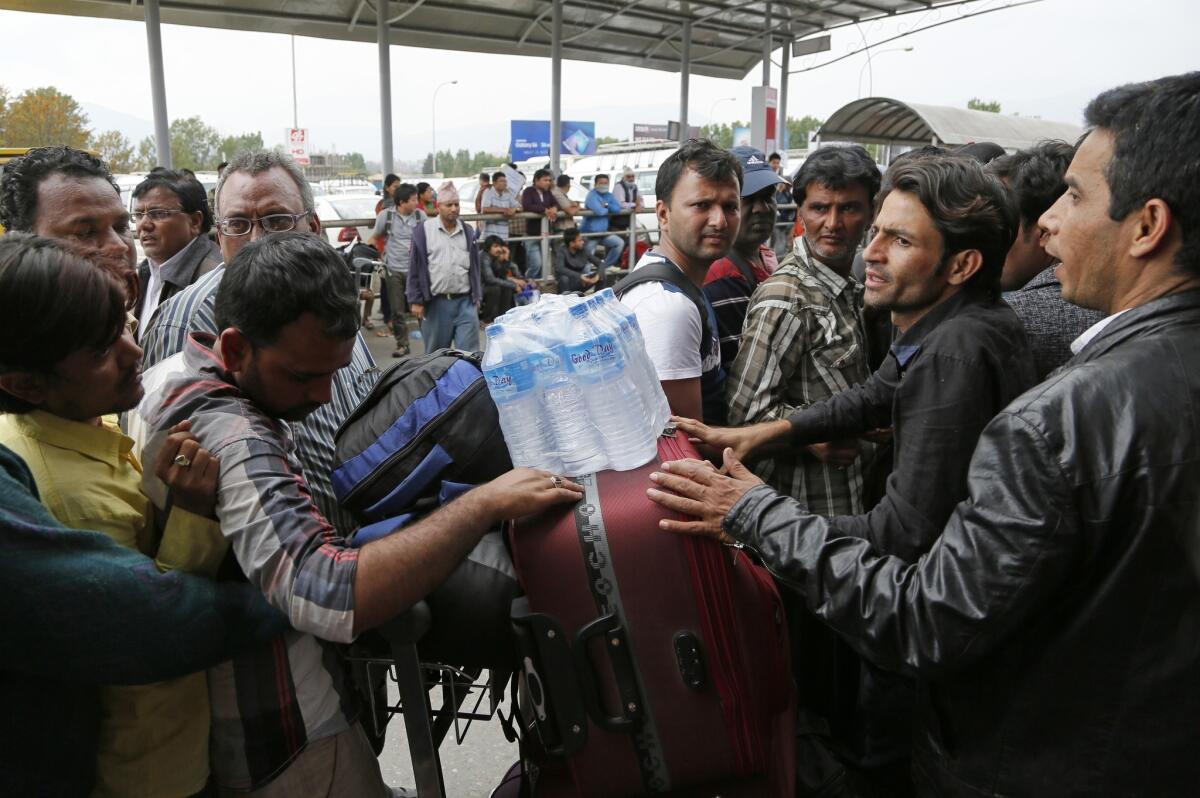After Nepal earthquake, chaos at Katmandu airport: ‘From Paradise to Hell’

- Share via
Reporting from Katmandu, Nepal — Under a yellow moon that hung like a wedge of lemon in the sky, Ole Andersen was camped at 3 a.m. Monday out front of Katmandu’s Tribhuvan International Airport with a green notebook, writing a story he called “From Paradise to Hell in a Few Seconds.”
When Saturday’s magnitude 7.8 earthquake wracked Nepal, the 66-year-old Danish adventurer, who had come to this Himalayan country to photograph insects, was staying at an organic farm outside the capital.
Suddenly, he said, “there was a big sound from deep underground, and everything began to shake.”
Bricks came tumbling down in his room on the second floor, blocking the stairwell.
Andersen grabbed his knapsack with his computer and climbed out the window, shimmying down to safety on a bamboo ladder.
“If I had a stomach,” said the wiry man, “I couldn’t have gotten out. Now I just want to go home to my family.”
Alongside Andersen seemed to be half the globe: Polish trekkers, Canadian vacationers, Indian migrant workers desperate to go home and Nepalese migrant workers desperate to get home.
There were men in monk’s robes and business suits, women in hiking gear and Indian saris. There were also scores of locals whose homes had been damaged or destroyed in the massive earthquake that killed more than 3,700 people.
They slept on pieces of cardboard and on luggage carts. Babies snuggled up against mothers; fathers coughed on cigarettes in the dead of night, their smoke momentarily blotting out the smell of people.
“We are afraid to go home, so we are sleeping here,” said Sanvee Ghimire as her 4-year-old daughter, Sabu, rested her weary head on her mother’s lap. “Our house has many cracks, and earthquakes are not stopping.”
The runway was as busy as the passenger terminal. Soldiers in green fatigues scurried to unload supplies from a giant gray Indian air force C-17 Globemaster as the new traffic rolled in: a Sri Lankan military plane, a private jet, passenger planes from China, Saudi Arabia, Turkey and India.
The plane traffic became so backed up that numerous flights were turned away Sunday and forced to return later.
Discarded paper and plastic water bottles littered the tarmac, giving the place the sad air of a site where a carnival had just passed through.
Luggage handlers stacked their carts high with suitcases and bundles from flights arriving from New Delhi; Muscat, Oman; and Istanbul, Turkey.
The number of passengers hoping to depart far outnumbered those arriving, but the baggage claim hall was stuffed with a veritable United Nations of travelers.
The pink and gray marble floor, cracked by the earthquake, was covered with travelers napping against walls and slumping against pillars. They would stir to life momentarily when a baggage carousel squeaked into motion to handle a few parcels.
Near the customs desk, a photo of some of Katmandu’s most beloved temples served as a reminder of what the quake had leveled.
A police officer whose name tag read “R. Sunar” napped under a sign that said simply, “Grievance Handling Desk.”
Apparently realizing the futility, or perhaps just worn out by exhaustion, no one was making much of a fuss.
Nick Douglas-Morris had flown in from Sydney, Australia, but his luggage was nowhere to be found. He had originally planned a 19-day trip from Katmandu to Tibet and back, followed by more than a week in neighboring Bhutan.
When the outfitter organizing his trip canceled the Tibet portion because of the earthquake, Douglas-Morris decided to come anyhow and try to find a way to volunteer for several weeks.
“I assume there’s something I can do to help people here. I don’t know if it’s wise or not. But if they don’t get tourist dollars, they will be in trouble,” he said.
He was not the only one carrying on with vacation plans in spite of the temblor. South Korean brothers Jaewoo and Geunman Park, ages 23 and 24, began planning a trip to Nepal several months ago, mapping out a journey from Katmandu to the base camp on the slopes of the Annapurna mountain.
In light of the quake, they didn’t know what they would find in Nepal, but they were determined to see the country. After their plane turned back once because Katmandu’s airport was too full, they arrived early Monday.
“I’ve been a member of Habitat for Humanity since I was 18, so I plan to try to find some of those people, or just walk into the UNICEF or Red Cross office and volunteer my time,” Jaewoo Park said.
Casey Allred, 29, a documentary filmmaker who splits his time between San Francisco, India and Nepal, was hauling his camera equipment off a baggage carousel.
His nonprofit, Effect.org, has been making a documentary called “Stolen Innocence” about human trafficking in Nepal and India. His friend Dan Fredinburg, a Google executive from California, died in an avalanche on Mt. Everest triggered by the earthquake. Nepal’s government said Sunday that more than 200 people remained missing on Everest.
“Dan was summiting [the mountain] on behalf of our film to raise awareness of this issue. We are just shocked by his loss,” Allred said. “We still haven’t been in contact with many of the NGOs [nongovernmental organizations] we work with. We’re really worried about all of them.”
Follow @JulieMakLAT on Twitter
More to Read
Sign up for Essential California
The most important California stories and recommendations in your inbox every morning.
You may occasionally receive promotional content from the Los Angeles Times.














